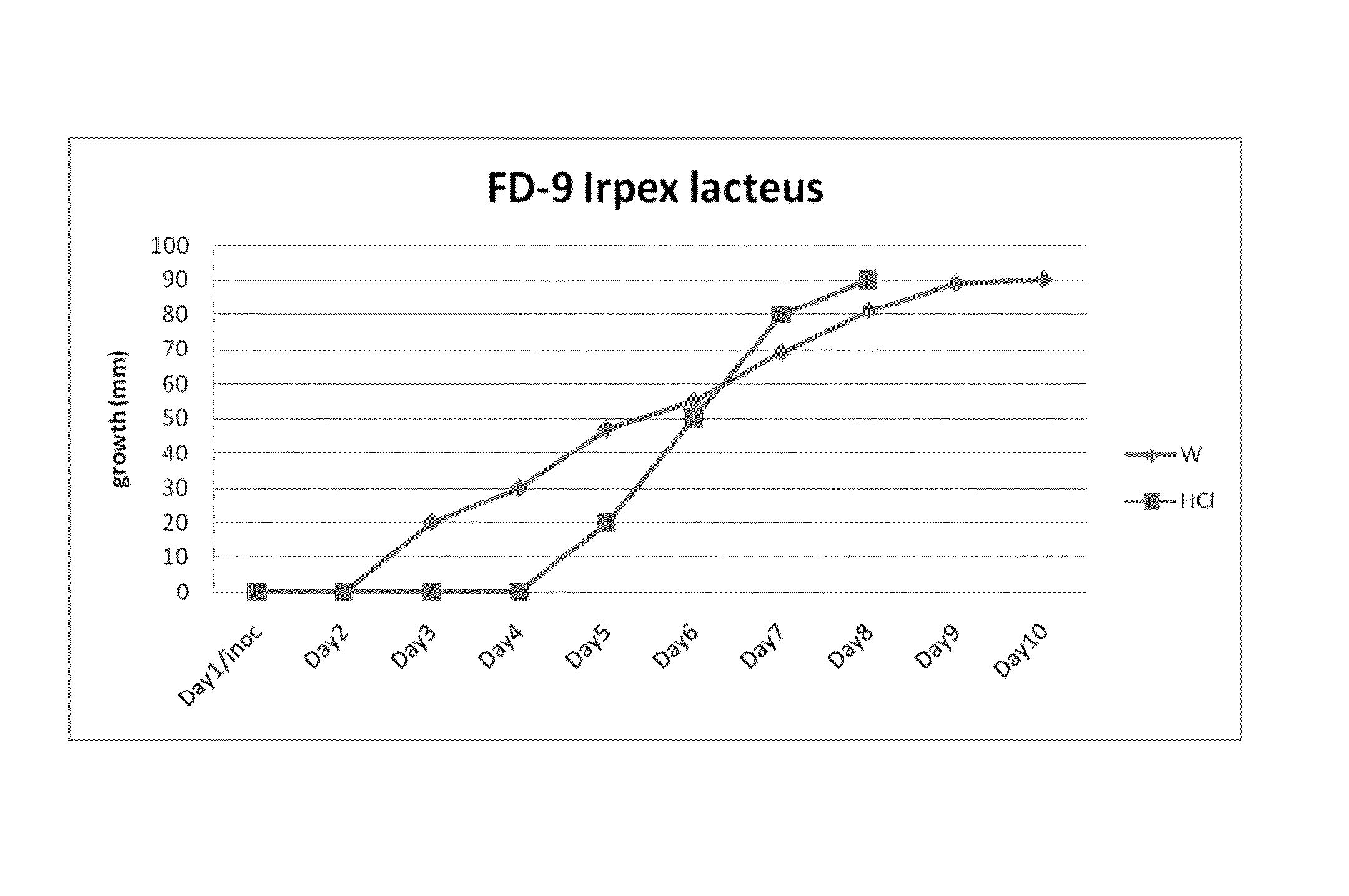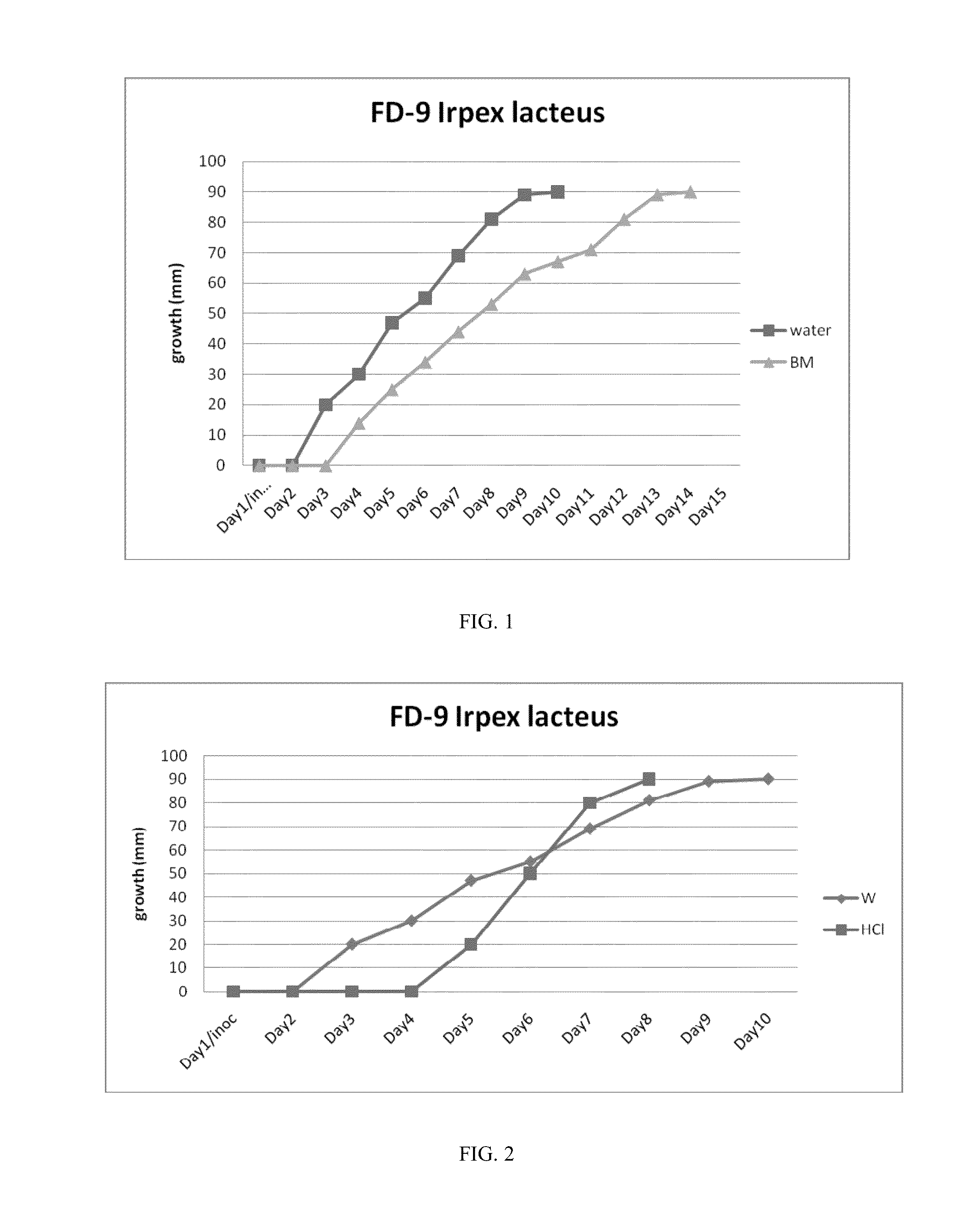Methods of culturing fungi and producing cellulases and chitin
a technology of cellulases and chitin, which is applied in the field of culturing fungi and producing cellulases and chitin, can solve the problems of not being exploited commercially, and i>aspergillus /i>and i>trichoderma /i>are difficult to degrad
- Summary
- Abstract
- Description
- Claims
- Application Information
AI Technical Summary
Benefits of technology
Problems solved by technology
Method used
Image
Examples
examples 1-8
[0028]Samples of Irpex lacteus were collected in the wild in Worcester County, Massachusetts, USA, and cultivated on malt yeast agar (MYA).
[0029]For Example 1, Irpex lacteus was cultivated in a glass Petri dish (100 millimeter internal diameter×25 millimeter depth) on a substrate consisting of water and a manufactured dried substrate precursor material with a high content of crystalline cellulose. An analysis of the dried substrate precursor material indicated that it contained 7,500 milligrams per kilogram of total nitrogen on a dry weight basis, and 1,200 milligrams per kilogram total phosphorus on a dry weight basis. Dispersing the dried substrate precursor material in water produced a pH of about 7. Water and dried substrate precursor material were mixed in a weight ratio of about 3:1. A ratio of less than 2:1 was insufficient to fully wet the dried substrate precursor material whereas a ratio of greater than 4:1 did not result in complete absorption of the water by the dried su...
examples 9-11
[0033]These examples illustrate the effect of two different nitrogen sources, urea and peptone, on the growth of Irpex lacteus.
[0034]In these experiments, the dried substrate precursor material was physically agitated (processed in a Waring blending) before being mixed with water. The physical agitation had the effect of making the dried substrate precursor material absorbent. As a result, a 5:1 weight ratio of liquid to dried substrate precursor material was used to prepare the substrate.
[0035]For Example 9, the liquid used to prepare the substrate contained 1.25 weight percent urea; the weight ratio of liquid to dried substrate precursor material was 5:1; two duplicate samples were prepared, each in a 250 milliliter Erlenmeyer flask with 10 grams of dried substrate precursor material, 50 grams of liquid, and 3 milliliters of a liquid culture in malt yeast medium.
[0036]For Example 10, the Example 9 procedure was used except that the liquid used to prepare the substrate contained 1...
example 12
[0038]This example illustrates cellulase extraction from an Irpex lacteus culture.
[0039]Five identical samples of culture medium were each prepared by mixing in a 250 milliliter flask 100 milliliters of water containing 6 milliliters per liter of 35% hydrochloric acid, 1 weight percent peptone, and 0.1 volume percent of the nonionic surfactant polyoxyethylene (20) sorbitan monooleate (obtained as TWEEN 80); and 20 grams of physically agitated dried substrate precursor material. After sterilization, the culture medium was inoculated with 3 milliliters of a liquid culture in malt yeast medium.
[0040]On each of days 7, 12, 15, 20, and 25, a sample was divided into four equal parts, with each part being transferred to a 250 milliliter flask. To each flask was added 150 milliliters of water containing 0.1 volume percent TWEEN 80 surfactant and 0.91 weight / volume percent sodium chloride. The substrate was dispersed thoroughly into the liquid and then it was shaken for 90 minutes at 180 rpm...
PUM
| Property | Measurement | Unit |
|---|---|---|
| Temperature | aaaaa | aaaaa |
| Time | aaaaa | aaaaa |
| Percent by mass | aaaaa | aaaaa |
Abstract
Description
Claims
Application Information
 Login to View More
Login to View More - R&D
- Intellectual Property
- Life Sciences
- Materials
- Tech Scout
- Unparalleled Data Quality
- Higher Quality Content
- 60% Fewer Hallucinations
Browse by: Latest US Patents, China's latest patents, Technical Efficacy Thesaurus, Application Domain, Technology Topic, Popular Technical Reports.
© 2025 PatSnap. All rights reserved.Legal|Privacy policy|Modern Slavery Act Transparency Statement|Sitemap|About US| Contact US: help@patsnap.com


